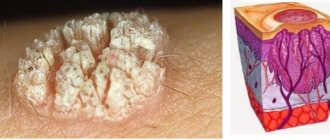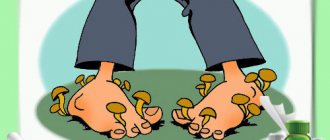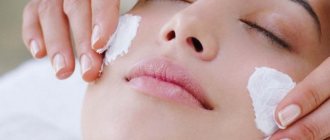What is mycosis of the feet
Mycosis of the foot is a group of fungal skin diseases, often with simultaneous damage to the nails. These infections cause similar clinical manifestations. They can only be distinguished after a microscopic examination of the skin and nails. Mycosis of the feet is a highly contagious disease. It is transmitted from person to person through household items: rugs in locker rooms, showers and swimming pools, footstools, basins and flooring in baths and saunas. Sharing shoes and socks is dangerous. The surface layer of the skin, which is constantly peeling off, contains a lot of fungi and their spores. Initially, the interdigital folds are affected and skin itching occurs. Subsequently, the infection takes over the entire foot and spreads to the nails. The course of the disease is long-term and requires constant treatment. To prevent mycosis of the foot, in our online store you can buy an effective prophylactic product - Mycospray.
Celandine
I present the treatment of foot fungus with folk remedies with the indispensable help of celandine, which has a general, effective antifungal effect. In the summer, we pick the celandine, at the place of the breakdown the orange juice we need will appear (maybe with a tint). With this same juice, we lubricate all existing sick and affected areas.
You may feel itching at first, but it will certainly begin to gradually disappear. This procedure should be repeated after 3.5 minutes. Thus, we repeat exactly 4 necessary times. It is important to do 2 such cycles during the current day. A month of treatment will bring huge changes and improvements.
Causes of mycosis of the feet
The cause of the disease is microorganisms of the genus Trichophyton, less commonly mold fungi and Epidermophyton floccosum:
- red trichophyton (Tr. Rubrum) causes up to 95% of all cases of the disease;
- approximately a third of patients also have interdigital trichophyton (Tr. Interdigitale);
- inguinal epidermophyton (E. floccosum) causes the disease in 1% of cases.
The likelihood of infection increases in unfavorable external conditions:
- high humidity;
- tight shoes;
- frequent visits to swimming pools, saunas and other wet areas;
- presence of a sick person in the family.
Some internal diseases also contribute to the development of fungal infections:
- sweaty feet;
- immunodeficiency;
- taking corticosteroid hormones orally;
- flat feet;
- Raynaud's disease, atherosclerosis of peripheral arteries, obliterating endarteritis, varicose veins;
- diabetes.
Diagnosis of candidiasis and its differentiation
You cannot determine candidiasis on your own, because similar symptoms may indicate other viral, bacterial or fungal diseases. To make a diagnosis, it is necessary to undergo a study consisting of several methods:
- an oral interview and medical history will help determine the general state of health and the presence of a predisposition to mycoses;
- examination (candidiasis is manifested by a white coating and large formations on the mucous membrane);
- smear for bacterial culture from the oral cavity;
- General blood and urine tests will indicate the presence of pathogens and inflammatory processes.
Based on the examination and test results, the doctor makes a diagnosis and prescribes treatment, based on the individual characteristics of the body.
Recommended video:
What happens during the disease
Mycosis of the feet rarely develops on healthy skin. Even if the fungus gets to the surface, it will not be able to penetrate the thick layer of intact epithelium. Under the influence of unfavorable external factors, the epidermis accumulates moisture and loosens. Fungi penetrate into the thickness of the skin and begin to actively multiply. This is further facilitated by vascular diseases and immune disorders, which are accompanied by impaired nutrition and local protective mechanisms on the feet. The proliferation of fungi causes damage to the interdigital areas, intense peeling and discomfort. The rejected epithelium ends up in socks and shoes, becoming a source of re-infection. Therefore, during the treatment of mycosis, it is necessary to treat the inner surface of the shoe with Mycospray.
Essential oils
Natural plant essential oils have antiseptic and anti-inflammatory effects.
To treat mycosis, tea tree oil, lavender, ylang-ylang, and rosemary are used. Used in the form of compresses and baths.
Recipes:
- Compresses. A little oil is heated to +30 degrees, mixed with two teaspoons of water. Soak a cotton swab well in the resulting mixture, apply it to the sore spot, secure it with an adhesive plaster and hold it for 40 minutes. Then the compress is removed, and the softened skin or nail is treated with a file.
- Baths. Add 10 drops of any oil to 3 liters of hot water. Pre-washed feet are placed in a container with flavored water for 20 minutes. After the procedure, wrap in a warm towel and leave for another 15 minutes.
Symptoms
Conventionally, the following forms of mycosis of the feet are distinguished, which are presented in the photo:
- Squamous: unilateral peeling and mild itching in the arch of the foot. This form often goes unrecognized.
- Intertriginous: the folds between the toes are affected, then the process moves to the back of the foot. Weeping cracks appear, accompanied by itching. A bacterial infection may accompany the development of erysipelas.
- Dyshidrotic: on the arch of the foot, vesicles with light and then cloudy contents form, merging with each other. They open with the formation of painful erosions. This type is accompanied by itching and pain.
Mycosis of the skin of the foot in the acute period can be accompanied by fever, poor health, headache, and enlarged inguinal lymph nodes. When infected with trichophyton, the nail of the 1st or 5th finger is affected, and subsequently the process spreads to all nail plates. First, yellow spots appear at the free edge of the nail, then it thickens, loosens and crumbles. Therefore, to treat foot fungus, you need to use complex action products, for example, Clotrimazole lotion for skin and nails.
The best folk remedies against nail fungus
Folk remedies for toenail fungus can be combined with pharmaceutical medications prescribed by a dermatologist. The results of therapy in this case will be higher.
At home, onychomycosis is treated with herbs, foods and substances:
- Iodine.
- Vinegar.
- Onion.
- Coffee.
- Garlic.
- Propolis.
- Kerosene.
- Novocaine.
- Birch tar.
- Essential oils.
- Tea mushroom.
- Hydrogen peroxide.
- Apricot resin tincture.
Let's consider the most effective measures in the treatment of nail fungus with folk remedies.
Treatment of mycosis of the feet
Therapy is carried out in 2 stages. First, it is necessary to eliminate acute inflammation and remove horny deposits on the feet. Warm foot baths with potassium permanganate and lotions with a solution of boric acid are shown. After removing the dense epithelium, creams containing anti-inflammatory hormones and antibiotics are used. After the inflammation subsides, these creams are replaced with similar ointments. At the second stage of treatment, antifungal ointments and creams (for example, Clotrimazole) are used. They should be applied to clean, dry skin 1 – 2 times a day, lightly rubbing. Not only the affected area is treated, but also the surrounding surface of the foot. The course of treatment takes about a month. Mycosis of the foot is successfully treated with the drug Clotrimazole lotion for skin and nails, which is offered in our online store for residents of Moscow and all regions. Its advantages:
- high activity against the fungus that causes mycosis of the feet;
- safety;
- hypoallergenic;
- affordable price.
Clotrimazole lotion can be used to treat other skin diseases:
- pityriasis versicolor;
- skin candidiasis;
- erythrasma;
- secondary bacterial infection against the background of mycosis.
The medicine is used 2 times a day, gently rubbing it into the affected areas. The skin must first be washed with soap and dried well, especially between the fingers. The course of treatment lasts until the symptoms of the disease disappear and for another 2 weeks. The drug is well tolerated. Only occasionally does it cause skin irritation. It has the only contraindication – the first trimester of pregnancy. Of course, clotrimazole is not used if you are hypersensitive to it. One of the advantages of clotrimazole lotion is the excellent penetration of the drug into the nail plates, which distinguishes it from cream or ointment. Regular use of this drug provides excellent results for mycosis of the feet and nails without the use of additional agents. Nail damage requires oral antifungal medications:
- itraconazole;
- fluconazole;
- griseofulvin;
- terbinafine
At the same time, medicinal varnishes are used, which are applied to the nails 1 – 2 times a week until complete healing.
Vinegar
The fungus is destroyed by an acidic environment, so vinegar is widely used for treatment; with its help, you can quickly get rid of the infection, relieve inflammation of the skin, and also restore the structure of the nail.
- For treatment, you need to prepare a vinegar solution in the proportion of 1 part vinegar to 8 water. In this case, the liquid should be at room temperature. Before treatment, feet should be steamed in hot water, and then the affected part of the nails should be removed. Then you should dip your feet in a basin with the prepared vinegar solution for 15 minutes. This procedure is carried out once every two days.
- Another way is to soak clean socks in a vinegar solution, put them on your feet, put woolen socks on top and go to bed like that. In the morning, feet should be rinsed with cool water and dried thoroughly. Clean the softened surface of the nail with a file and treat with an antiseptic solution.
If desired, you can add essential oils to the water, such as peppermint, rosemary, lavender and eucalyptus oil. They have a relaxing, anti-inflammatory and antiseptic effect and allow you to destroy fungal spores in a short time.
Preventive methods
Treatment of a fungal infection takes a long time. Mycosis of the feet requires the use of drugs, the cost of which is quite high. Prevention of the disease is especially important in people with risk factors for the disease. Athletes, swimmers, and hot shop workers are recommended to regularly use antifungal and antibacterial drugs, for example, Mycospray. This product is safe, does not damage the skin and does not cause irritation. With its regular use, the likelihood of becoming infected with foot fungus is sharply reduced. Mycospray is useful for preventing re-infection. To do this, the drug must be sprayed monthly on the inner surface of the shoes. Mycospray is safe even with long-term use. It should be applied to dry, clean skin of the feet before each visit to the pool and other similar places. There are no contraindications to the use of this drug. It should be used with caution only by pregnant and breastfeeding women. It is necessary to eliminate the external causes of the disease:
- wear boots and shoes that fit;
- use high-quality sports shoes made from natural materials;
- wash your feet daily and treat your nails on time;
- fight sweaty feet;
- When visiting a bathhouse, swimming pool, or beach, it is better to use lightweight silicone or rubber slippers.
General strengthening of the immune system, treatment of diabetes and vascular diseases are necessary.
Application of propolis
This product is actively used in folk medicine to treat many diseases, including fungal infections. There are several known recipes for using propolis:
- Daily overnight compresses from alcoholic propolis tincture are made using a cotton pad generously soaked in it, which is covered with a dry cloth, bandaged and warm socks are put on.
- Apply a piece of propolis to cleanly washed and steamed problem areas and leave for 30 minutes. The procedure is repeated every day twice.
Giving up bad habits is a significant contribution to the prevention of foot fungus
Bad habits (excessive alcohol consumption, smoking, drug addiction), improper wakefulness-sleep, work-rest patterns, inappropriate behavior in stressful situations usually lead to a serious decrease in immunity and poor circulation.
Unreasonable unbalanced nutrition, excessive consumption of light carbohydrates, physical inactivity lead to obesity. Against the background of weakened immunity, poor circulation and obesity, a favorable climate is formed for infection and the development of infection into a generalized dangerous disease.
This indicates an urgent need to give up bad habits.
Prevention
It is better to prevent any disease than to treat it later. For patients who are at risk, it is recommended to carry out preventive measures twice a year. These include taking antifungal medications and immune-boosting vitamins. Also, to avoid candidiasis of the oral mucosa, you need to eat right, maintain personal hygiene, and go to the hospital in a timely manner.
In summary, it should be noted that candidiasis is easily treated when the first symptoms appear. If the disease is prolonged, complications begin. To avoid side effects and relapses, you need to take antifungal drugs and act locally on plaques that appear in the mouth as the disease develops.
Recommended video:











